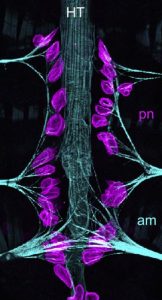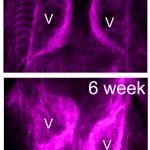

It may surprise you but your heart is nothing new. Insects that evolved nearly half a billion years ago had already developed beating hearts. Much of the genetic machinery that controls our own heart beat and heart’s contraction has been conserved during evolutionary time – nature has not deemed it necessary to change it much. OK, the scale and shape of our hearts has changed a little since flies evolved but the molecular mechanics underpinning each heart beat haven’t. This means we can use flies and their genetics to understand human hearts. This is especially useful for ageing research when other models are simply too challenging to manipulate. Research work funded both in the UK by the British Heart Foundation and the USA by the National Institutes of Health is now being summarised in this review. The image shows the Drosophila (fruit fly) heart tube (HT) with associated kidney-like cells either side of it (purple) and alary muscles which act like guy ropes, pinning the heart to the fly’s abdomen. Remember this the next time you wash your car’s window-screen – you’re scraping away a lot of very cool biology!
Dr. Paul S. Hartley – your local ‘heart Drosophilist’
 Molecular basis for a healthier heart…new work published by BU
Molecular basis for a healthier heart…new work published by BU Strong Presence of BU at UK Kidney Week
Strong Presence of BU at UK Kidney Week










 Dr. Ashraf cited on ‘Modest Fashion’ in The Guardian
Dr. Ashraf cited on ‘Modest Fashion’ in The Guardian NIHR-funded research launches website
NIHR-funded research launches website Academics write for newspaper in Nepal
Academics write for newspaper in Nepal New paper published on disability in women & girls
New paper published on disability in women & girls MSCA Postdoctoral Fellowships 2025 Call
MSCA Postdoctoral Fellowships 2025 Call ERC Advanced Grant 2025 Webinar
ERC Advanced Grant 2025 Webinar Horizon Europe Work Programme 2025 Published
Horizon Europe Work Programme 2025 Published Horizon Europe 2025 Work Programme pre-Published
Horizon Europe 2025 Work Programme pre-Published Update on UKRO services
Update on UKRO services European research project exploring use of ‘virtual twins’ to better manage metabolic associated fatty liver disease
European research project exploring use of ‘virtual twins’ to better manage metabolic associated fatty liver disease